Turbocharger
nonlinear rotordynamics
MAJOR APPLICATION: Passenger vehicle (PV) and commercial vehicle (CV)
turbochargers, micro-turbomachinery
Sponsor: Honeywell Turbo Technologies (HTT) 2000-2012,
Turbomachinery Laboratory
INDUSTRIAL FUNDING (00-12) $812,500
|
2011,
January |
Research Progress Overview on Turbocharger NL Bearings and
Rotordynamics |
|
2010,
September |
8th IFToMM International
Conference on |
|
Nonlinear
Rotordynamics of Vehicle Turbochargers: Parameters Affecting Sub Harmonic Whirl frequencies and Their Jump |
|
|
Undergraduate
research |
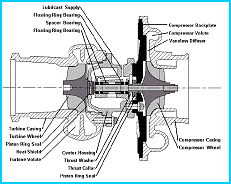
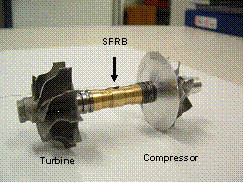
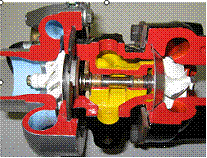
Turbochargers supported on semi-floating
ring bearings and fully-floating ring bearings. Donations from Honeywell Turbo
Technologies
Objective: To advance (experimentally validated)
computational tools for prediction of the dynamic forced response of turbocharger
rotors supported on FRBs. Applications for PV
(passenger vehicles) and CV (commercial vehicles)
Status:
Honeywell Turbo Technologies continuously support this project since
2000. The turbocharger (TC) test rig was dismantled after testing three TC
units. DAQ system and instrumentation developed to record shaft motions to 200
krpm, including floating ring speed. A Virtual Laboratory for prediction of TC
response is currently in place. The work aims to correlate nonlinear model
predictions with test data available from the sponsor Hot Gas Test Stands in LA
and France. The computational tool allows for fast product development with
substantial savings to the sponsor.
Current
Work proprietary
VIRTUAL LABORATORY
Numerical
predictions based on XLTRC2 and bearing nonlinear models (XLBRG) show excellent correlation with test data
for a TC supported on fully-floating ring bearings as well as for a unit
supported on semi-floating ring bearings. The side load due to the feed
pressure must be accounted in the analysis to predict reliable results
comparable to the test data.
The latest version
of XLBRG features seven different heat convection
models. In addition, based on bearing geometry, XLBRG features three types of bearing models:
a)
Bearing
with inlet feed pressure at ONE END
b)
Bearing
with inlet feed pressure at MIDPLANE
c)
Bearing
with UNEQUAL LENGTHS (LEFT & RIGHT) inlet feed pressure at center between
lands
Some of the major
advances in analytical study conducted at Turbo Lab include but are not limited
to:
a)
Predictions
of linear and nonlinear responses of various Turbochargers (TC) with constant
shaft speed
b)
Effect
of compressor cross coupled stiffness and thrust bearing moment coefficients on
TC dynamic response
c)
Effect
of increasing inner film clearance on TC shaft motions
d)
Predictions
of TC transient speed response with various acceleration and deceleration rates
e)
Predictions
of TC nonlinear response with engine housing base excitations
f)
Modifications
of the XLTRC2 Excel GUI to be compatible with new bearing features
in XLBRG
Please note that
in most cases predictions are validated against test data. Rotor models
developed in XLTRC2 are validated by measuring their free-free mode
natural frequencies and mode shapes.
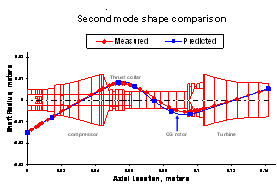
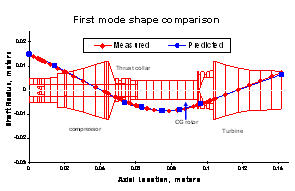

TEST RIG FACILITY
Example of a XLTRC2 TC rotor model
supported on FRBs
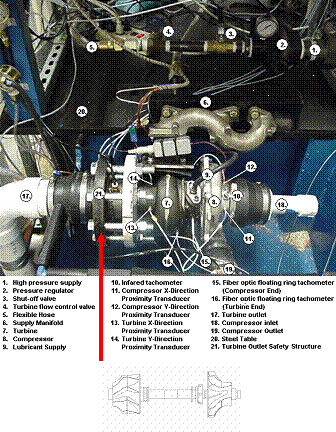

Predicted and measured TC dynamic response – shaft speed 29
to 243 krpm

INDUSTRIAL FUNDING FOR PROJECT $812,500
|
$ 208,340 |
Turbocharger Bearing Code Development |
09/01/10 08/31/12 |
||
|
$ 438,160 |
Computational Analysis of Floating Ring Journal Bearings and Experimental Validation in a Turbocharger Test Rig – Phase I-IV |
01/01/03- 12/31/09 |
||
|
$ 42,000 |
Feasibility Study of Bearing Technologies for Oil-Free Turbochargers |
05/01/01 08/31/02 |
||
|
$ 129,000 |
Computational Analysis of Floating Ring Journal Bearings and Experimental Validation in a Turbocharger Test Rig |
05/01/00 08/30/02 |
||
To learn more,
order/read our PUBLICATIONS